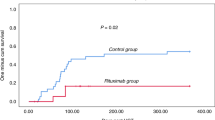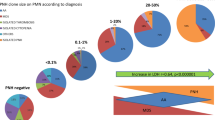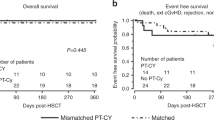Abstract
A patient with paroxysmal nocturnal hemoglobinuria (PNH) received a syngeneic peripheral blood stem cell transplant (PBSCT) with high-dose cyclophosphamide (CY) conditioning. He had a reasonable engraftment and complete hematologic recovery. However, at 12 months after PBSCT, he became symptomatic and peripheral blood cells were almost entirely composed of glycosylphosphatidylinositol-anchored proteins deficient cells. This case suggests that high-dose CY may not exert a significant effect on PNH clones in the long term, although it had been effective in allogeneic BMT. In view of the possible autoimmune basis, it seems to be necessary to include other immunosuppressive therapy including ALG in addition to CY. Bone Marrow Transplantation (2001) 28, 987–988.
This is a preview of subscription content, access via your institution
Access options
Subscribe to this journal
Receive 12 print issues and online access
$259.00 per year
only $21.58 per issue
Buy this article
- Purchase on Springer Link
- Instant access to full article PDF
Prices may be subject to local taxes which are calculated during checkout
Similar content being viewed by others
References
Kawahara K, Witherspoon RP, Storb R . Marrow transplantation for paroxysmal nocturnal hemoglobinuria Am J Hematol 1992 39: 283–288
Kolb HJ, Holler E, Bender-Götze C et al. Myeloablative conditioning for marrow transplantation in myelodysplastic syndromes and paroxysmal nocturnal hemoglobinuria Bone Marrow Transplant 1989 4: 29–34
Hershko C, Ho WG, Gale RP, Cline MJ . Cure of aplastic anemia in paroxysmal nocturnal hemoglobinuria by bone marrow infusion from identical twin: failure of peripheral-leukocyte transfusion to correct marrow aplasia Lancet 1979 1: 945–947
Champlin RE, Feig SA, Sparkes RS, Gale RP . Bone marrow transplantation from identical twins in the treatment of aplastic anemia implications for the pathogenesis of the disease Br J Haematol 1984 56: 455–463
Endo M, Beatty PG, Vreeke TM et al. Syngeneic bone marrow transplantation without conditioning in a patient with paroxysmal nocturnal hemoglobinuria: in vivo evidence that the mutant stem cells have a survival advantage Blood 1996 88: 742–750
Szer J, Deeg HJ, Witherspoon RP et al. Long-term survival after marrow transplantation for paroxysmal nocturnal hemoglobinuria with aplastic anemia Ann Intern Med 1984 101: 193–195
Brodsky RA, Sensenbrenner LL, Jones RJ . Complete remission in severe aplastic anemia after high-dose cyclophosphamide without bone marrow transplantation Blood 1996 87: 491–494
Luzzatto L, Bessler M, Rotoli B . Somatic mutations in paroxysmal nocturnal hemoglobinuria: a blessing in disguise? Cell 1997 88: 1–4
Nafa K, Bessler M, Deeg HJ, Luzzatto L . New somatic mutation in the PIG-A gene emerges at relapse of paroxysmal nocturnal hemoglobinuria Blood 1998 92: 3422–3427
Antin JH, Ginsburg D, Smith BR et al. Bone marrow transplantation for paroxysmal nocturnal hemoglobinuria: eradication of the PNH clone and documentation of complete lymphohematopoietic engraftment Blood 1985 66: 1247–1250
Author information
Authors and Affiliations
Rights and permissions
About this article
Cite this article
Cho, S., Lim, J., Kim, Y. et al. Conditioning with high-dose cyclophosphamide may not be sufficient to provide a long-term remission of paroxysmal nocturnal hemoglobinuria following syngeneic peripheral blood stem cell transplantation. Bone Marrow Transplant 28, 987–988 (2001). https://doi.org/10.1038/sj.bmt.1703259
Received:
Accepted:
Published:
Issue Date:
DOI: https://doi.org/10.1038/sj.bmt.1703259



